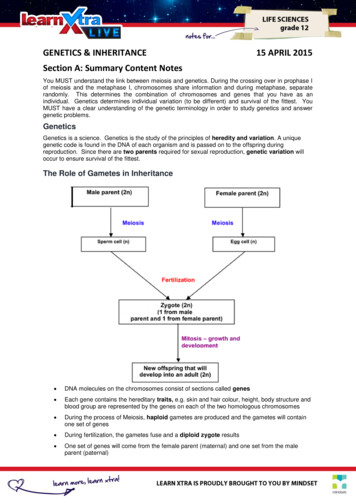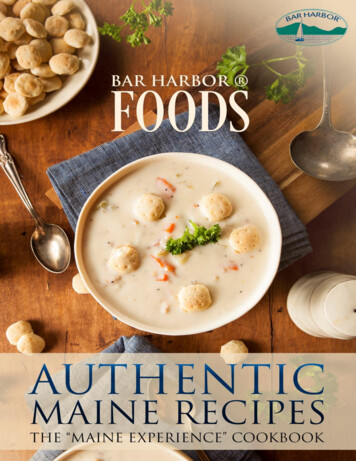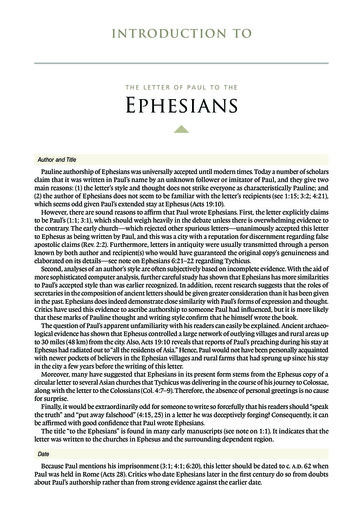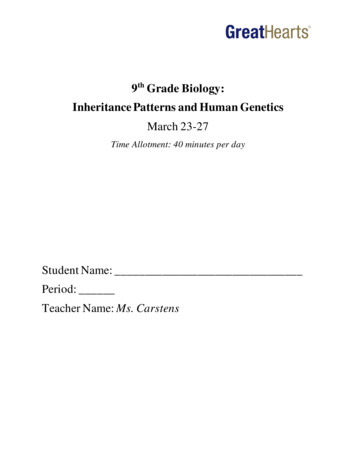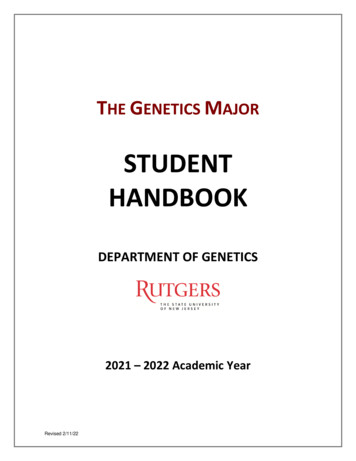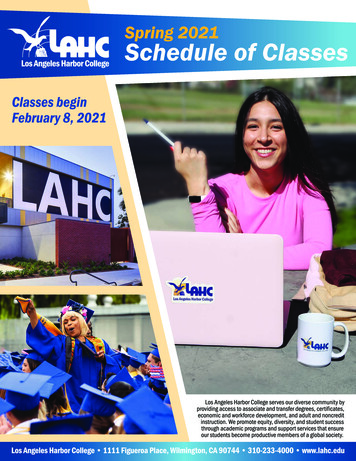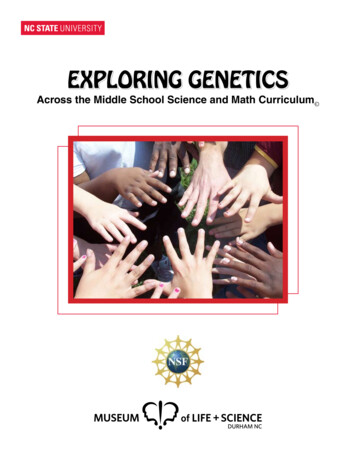
Transcription
Exploring GeneticsAcross the Middle School Science and Math Curriculum
Table of ContentsWelcome Letter from Dr. Bill Thompson. iAcknowledgements and Biographies. iiOverview of the Genetics Science in a Suitcase Kit and Manual. iiiReferences and Resources. vScience Vocabulary. viiiMath Vocabulary. xiiScience ActivitiesOverview of the Genetics Science in a Suitcase Kit and Manual. xviNorth Carolina Standard Course of Study for Middle Grades Science Chart. xviiNorth Carolina Standard Course of Study for Middle Grades Science Curriculum. xviiiActivity 1: Heredity & Genetics Scavenger Hunt . . 1Activity 2: A Personal Survey of Inherited Human Traits . 7Activity 3: Modeling Mendel: Predicting the Outcome of Genetic Crosses . 15Activity 4: Punnett Squares . . 21Activity 5: Genetic Offspring Models . . 32Activity 6: Extracting DNA from Wheat Germ. 39Activity 7: DNA, Genes, and Proteins . 46Activity 8: A Day in the Life of DNA . . 51Activity 9: Genetic Disorders . . 57Activity 10: Genetic vs. Environmental Influences on Traits . 64Math ActivitiesOverview of the Genetics Science in a Suitcase Kit and Manual.72North Carolina Standard Course of Study for Middle Grades Science Chart. 73North Carolina Standard Course of Study for Middle Grades Math Curriculum. 74Activity 1: Heredity & Genetics Scavenger Hunt . . 79Activity 2: Understanding and using data from the inherited Human Traits survey/activity . 82Activity 3: Overview: How Punnet squares may be used as a Mathematical tool . 88Activity 4: Solving Real World Problems through Math and Science . 92Activity 5: Background Experience in the Laboratory . 95Activity 6: Identifying Various Views. 98Activity 7: Data Analysis to Further Scientific Reasoning . 102Activity 8: Gattaca . . 110Activity 9: Math Extension for Science Activity 9 [Nature Vs Nurture] . 114
North Carolina State University is a landgrant university and a constituent institutionof The University of North CarolinaNC STATE UNIVERSITYCollege of Agriculture and Life SciencesDepartments of Plant Biology, Genetics,and Crop ScienceCampus Box 7550Raleigh, NC 27695-7550August 2007919.515.2727919.515.3436 (fax)Dear Middle Grades Educator,This kit “Genetics Across the Middle School Science and Math Curriculum” has beendesigned with you in mind. Our team of university scientists, middle grades classroomteachers, middle school students, and museum educators developed and tested theactivities in a school setting. The activities are easily implemented and follow the NorthCarolina Standard Course of Study in both a science and math requirement within theStandard Course of Study for the middle school grades. The career information, reflection activities, and the inquiry based nature of the activities provide a well rounded introduction to genetic science and its relation to mathematics at the middle grades level.The kit was developed as an outreach project for National Science Foundation projectin plant genomics (DBI-0421651). I am very grateful to the Foundation for continuingsupport. In addition, I’d like to thank the NCSU co-Principal Investigators working withme on this project for their involvement and dedication: Dr. Linda Hanley-Bowdoin,Dr. George Allen, and Dr. Bryon Sosinski. I’d also like to thank the postdoctoralassociates and graduate students who contributed their time and expertise:Dr. Sharon Settlage, Dr. Tae-Jin Lee, Dr. Randall Shultz, Miguel Flores, andMariana Franco-Ruiz. For more information on this project visit www.plantreplication.org.Most of the credit for the activities contained within this project goes to Hawley MiddleSchool (Granville County, NC) teachers Dr. Jeff Batten and Rob Caine for their development, testing, and scrutiny from a teacher’s point of view of each activity. Jeff and Robspent countless hours of creative energy in pursuit of the best possible explanation ofgenetic science to a middle grade student. All of us at NCSU enjoyed getting to knowthese two talented and dedicated teachers.A word of thanks is also in order for Shawntel Landavazo and Nancy Dragotta-Muhl atthe Museum of Life and Science in Durham, NC. Their insight into classroom teacherchallenges, science kit construction, and activity alignment to the North CarolinaStandard Course of Study was instrumental to refining the kit.Finally, a very important word of thanks goes to Carol Cutler-White for developingthe concept, creating the collaboration, and managing the project.I trust you will find this kit to be highly valuable as you teach science and math atyour school.Sincerely,Dr. William F ThompsonUniversity Research ProfessorNorth Carolina State UniversityCampus Box 7550Raleigh, NC 27605i 2007 North Carolina State University.
Acknowledgements and BiographyACKNOWLEDGEMENTSSpecial thanks to:Dr. Julie Hicks for helpful scientific and editorial suggestions.Todd Guentensberger from Duke University CIBL (Center for Inquiry-Based Learning)for helpful suggestions on developing an Inquiry Based science kit for middle schools.Dr. Batten’s students who assisted development and testing of the Genetics Kit includingSamantha Capps, Ben McCuiston, Lizandra Valdes, Ashley Carrion, Devonte Terry, MistyRiley, Taylor Upchurch, Alea Satterwhite, Michaela Howell, Thomas Campbell, MichaelFoster, and Matthew Higgs.Reproduction of materials in this manual for any use requires permission from NorthCarolina State University. To obtain permission, please contact Dr. George Allen atgeorge allen@ncsu.edu.BIOGRAPHYDr. Jeffrey Batten received M.S. and Ph.D. degrees in Plant Pathologyand Microbiology from Texas A&M University, where he studied howplant viruses replicate. During graduate school, he became interestedin science education and developed several hands-on workshops forstudents. After finishing his Ph.D., Dr. Batten continued researching thebiochemistry of plant viruses during his postdoctoral research at NCState University. During this time he also designed and facilitated workshops for Sally Ride Science Festivals. These workshops provided middle school girlswith unique opportunities to learn about how beneficial microbes influence our everydaylives. In 2004, Dr. Batten accepted a position at G.C. Hawley Middle School in GranvilleCounty, where he is currently teaching middle school science.Robert Caine received his degree in education from The Port ElizabethCollege of Education. He furthered his degree with a year in Cape TownCollege of Education, South Africa, where he majored in math, science,physical education and geography. Robert taught 6 years in South Africaand in North Carolina for 7 years. He recently completed his NationalBoards in mathematics. Currently teaching at G.C. Hawley MiddleSchool in Granville County, Robert also serves as the Math Chairperson, a mentor and trainer during staff development.ii 2007 North Carolina State University.
OverviewUsing the Exploring Genetics Across the Middle GradesScience and Math Curriculum ManualThis manual was designed to leverage the interdisciplinary and inquiry based learning potentialof genetics within science and math. In studying genetics within the context of both science andmath, students will be able to increase their understanding and the application of genetic science within their world. While we focus on the “what” of learning, this manual also focuses onthe “why” of genetic science. Students will be required to conduct experiments within the scienceactivities and analyze the data within the math activities. Their learning will parallel the researchbeing conducted at NC State which funded the development of this manual. Genetic scientistsgenerate raw data through their research. They must work in collaboration with statisticians andcomputer scientists to process and analyze the data in order to draw conclusions. If studentscan grasp the overlap of the two disciplines, they will understand the current state of scientificresearch.There are two distinct sections to the manual; science and math. To increase the effectivenessof the material, the two subjects would be implemented at the same time. However, realizing thediverse nature of public school schedules, teaching loads, and the many obstacles teachers faceeach day, the manual is designed with two options for implementation. The nine activity scienceportion is a stand alone set of activities. It can be implemented within the science curriculum andmeet the objectives of many strands of the North Carolina Standard Course of Study. The mathactivities analyze data generated through the science activities, and are therefore dependentupon the activity taking place within the science curriculum. We encourage the interaction of thescience and math departments as you undertake the activities within this kit and manual.Alignment to the North Carolina Standard Course of StudyBoth the science and the math activities are aligned to the North Carolina Standard Course ofStudy. The alignment is noted on the content specific chart included within this manual. Additionally, the Standard Course of Study objectives are listed within each activity. Science activities arealigned to the 7th grade Standard Course of Study. The math activity alignment encompasses6th to 8th grade increasing the flexibility of the classroom application.Using the Genetics Science in a Suitcase Kit from the Museum of Life and ScienceThis manual is designed to be used with supplies provided through the Museum of Life andScience titled Genetics Science in a Suitcase. All of the supplies listed in the Materials List areincluded in the kit. If you received a copy of this manual without renting the kit from the Museum,it is possible to conduct the activities with basic supplies found at local department stores. If youwould like to rent the kit, please contact: Nancy Dragotta-Muhl, Phone: 919.220.5429 (x362),Email: nancy.dragotta-muhl@ncmls.org.Career information and high school course sequencingIncluded within the kit from the NC Museum of Life and Science is a Career Pathways book published by the North Carolina Biotechnology Center and the NC Department of Public Instruction.We encourage you to incorporate this career information, because it assists them with planningtheir course sequence for the high school curriculum. The Career Pathways book is availableonline at: reer pathways/biotechnology career publication.pdf. Parents may also be interested in this information as it relates to planningthe high school course curriculum.iii 2007 North Carolina State University.
Textbook ResourcesThis kit is designed to be used as a stand-alone unit or in conjunction with the three mainseventh grade science textbooks currently used in the Triangle school districts:Prentice Hall, McDougal Littell, and Holt.McDougal Littell Science Integrated Course 2, Teacherâ s EditionGrade 7 Science North Carolina Edition,McDougall Littell, Evanston, ILCopyright 2005ISBN: 0-618-46999-0unspecified number of pagesPrentice Hall Science Explorer North Carolina Grade 7, Teacherâ s EditionPearson Prentice Hall, Upper Saddle River, NJCopyright 2005ISBN: 0-13-125791-9817 pagesHolt Science & Technology, North Carolina Grade 7, Studentâ s EditionHolt, Rinehart, and Winston, Orlando, FLCopyright 2005ISBN: 0-03-022263-1696 pagesiv 2007 North Carolina State University.
References and ResourcesTHE BIOLOGY BINDER, Jessica Lupold, Orange County High School, Virginiahttp://www.biologybinder.com/CELERA GENOMICShttp://www.celera.comDECIPHERING THE GENETIC CODE, Office of NIH S1 mendel.htmDNA EXTRACTIONS, Lana Hays, Access Excellencewww.accessexcellence.org/AE/AEC/CC/DNA extractions.htmlDNA FROM THE BEGINNING, Cold Spring Harbor Laboratorywww.dnaftb.org/dnaftb/DOE JOINT GENOME INSTITUTEhttp://www.jgi.doe.govFLINN SCIENTIFIChttp://www.flinnsci.comGENETIC DISORDERS, Genetic Science Leanring Center, University of GENETIC SCIENCE LEARNING CENTER, University of Utahhttp://gslc.genetics.utah.eduGENETICS EDUCATION CENTER, University of Kansas Medical Centerhttp://www.kumc.edu/gec/HBB: GENE ASSOCIATED WITH SICKLE CELL ANEMIA, Gene Gateway, Human /Human Genome/posters/chromosome/hbb.shtmlHUMAN GENETICS ONLINE SURVEY, Vailsburg Middle School, 0Genetics/index2.htmHUMAN GENOME PROJECT, U.S. Dept of Energyhttp://genomics.energy.govMITOSIS IN ANIMAL CELLS, J Warner, University of North Carolina - notes1/labpics/lab6pics.htmMITOSIS IN ONION ROOT TIPS, Michael Davidson, Florida State y/mitosis/mitosis.htmlv 2007 North Carolina State University.
REFERENCES AND RESOURCES (cont.)MITOSIS IN ONION ROOT TIPS, Paul Decelles, Johnson County Community College, tip.htmlNATIONAL HUMAN GENOME RESEARCH INSTITUTEhttp://www.genome.govNATIONAL SCIENCE TEACHERS ASSOCIATION SCILINKShttp://www.SciLinks.orgNIH CURRICULUM SUPPLEMENT /NORTH CAROLINA HEALTH INFOhttp://www.nchealthinfo.orgNORTH CAROLINA STANDARD COURSE OF STUDY, DEPARTMENT OFPUBLIC um/NORTH CAROLINA STATE UNIVERSITY GENOMICS PROGRAMhttp://www.genomics.ncsu.eduPLANT MITOSIS, Dale Benham, Nebraska Wesleyan itosis/allium.htmlPUNNETT SQUARE CALCULATOR, Chang punnett.htmlPUNNETT SQUARE EXAMPLES, Anthro PRODUCTION AND HEREDITY, Utah State Office of s/sciber99/7th/genetics/sciber/intro.htmSCIENCE JOURNAL, imeline.dtlSCIENCE OF HEREDITY, Charles Mallery, University of Miamihttp://fig.cox.miami.edu/ cmallery/150/mendel/heredity.htmSCIENTIFIC AMERICAN THE GENE MACHINE, Bill Kendrickhttp://www.sonic.net/ nbs/projects/bio115l/vi 2007 North Carolina State University.
REFERENCES AND RESOURCES (cont.)THE STORY OF MENDEL, Bill Kendrickhttp://www.sonic.net/ .orgWHITEFISH MITOSIS, Barbara Krumhardt, Des Moines Area Community College, EFISH BLASTULA MITOSIS, Steven Scadding, University of Guelph, htmlYOUR GENES YOUR HEALTH, Cold Spring Harbor Laboratoryhttp://www.ygyh.orgvii 2007 North Carolina State University.
Science VocabularyACQUIRED TRAIT characteristic that is obtained during the lifetime of an individual as a resultof their experiences.ALLELE one of the variant forms of a gene at a particular locus, or location, on a chromosome.Different alleles produce variation in inherited characteristics such as hair color or blood type.In an individual, one form of the allele (the dominant one) may be expressed more than anotherform (the recessive one).BIOTECHNOLOGY use of techniques that involve manipulating the biology of organisms suchas bacteria, fungi, virus, and plants. One type of biotechnology involves using recombinant DNAto create modified organisms with desirable traits. Roundup Ready corn is an example of thistype of genetically modified organism (GMO) which contains a recombinant gene that protectscorn from the herbicide Roundup.BREEDING application of genetic principles to improve the traits of organism. Breeding caninvolve both traditional and molecular techniques to create offspring with desirable traits.CANCER diseases in which abnormal cells divide and grow unchecked. Cancer can spreadfrom its original site to other parts of the body and can also be fatal if not treated adequately.CENTRAL DOGMA theory developed by Francis Crick that describes the sequential transfer ofgenetic information from DNA (genes) ’ RNA ’ protein in eukaryotic organisms. Some organismssuch as retroviruses are able to convert RNA back into DNA.CHROMOSOME a structure that is made up of thread-like strands of DNA and is used to organize the genetic information in a cell. Different species have different numbers of chromosomes.For example, humans have 23 homologous pairs of chromosomes (46 total), while the fruit fly(Drosophila) only has4 pair (8 total).CYSTIC FIBROSIS (CF) an inherited (genetic) disease that is caused by a defect in the CFTRgene which affects mucus production. The disease affects several organ systems including therespiratory, digestive, integumentary, and reproductive systems.CYTOPLASM a gel-like matrix between the nucleus and the cell wall which contains a cell’sorganelles, and is where RNA is translated into proteins.DNA (DEOXYRIOBNUCLEIC ACID) chemical inside the nucleus of a cell that carries the geneticinstructions for making living organismsDOMINANT ALLELE gene that almost always results in a specific physical characteristic, forexample, a disease, even though the patient’s genome possesses only one copy.DOWN SYNDROME (Trisomy 21) an inherited (genetic) disease caused by a person havingand extra copy of chromosome 21.viii 2007 North Carolina State University.
SCIENCE VOCABULARY (cont.)FERTILIZATION act of rendering gametes fertile or capable of further developmentGAMETE a reproductive cell that has a haploid number (single set) of chromosomes(example - human sperm or egg).GENE functional and physical unit of heredity passed from parent to offspring, most of whichcontain information for the production of proteins.GENERATION class composed of all individuals removed by the same number of successiveancestors from a common predecessor.GENE THERAPY evolving technique used to treat inheritied diseases. The medical procedureinvolves either replacing, manipulating, or supplementing nonfunctional genes with healthygenes.GENETIC CODE the sequence of DNA or RNA bases that determine the sequence of aminoacids in proteins of an organism.GENETIC CROSS the intentional breeding of two individuals to obtain offspring with specifictraits.GENETIC DISEASE (INHERITED DISORDER) a pathological condition caused by aberrationsin genes or chromosomes.GENETIC ENGINEERING using molecular biological techniques to alter the genome of anorganism.GENETICS the study of genes and their heredity.GENETICALLY MODIFIED ORGANISM (GMO) an organism whose genetic material (genome)has been altered using recombinant DNA technology (example – Roundup Ready corn).GENOMICS study of the structure and function of the genome, including information about sequence, mapping, and expression, and how genes and their products work in organisms.GENOTYPE genetic identity of an individual that does not show as outward characteristics.HEMOGLOBIN the iron-containing protein in the blood that transports oxygen and carbon dioxide throughout the body.HEREDITY genetic transmission of a particular quality or trait from parent to offspring.HETEROZYGOUS (HYBRID) possessing two different forms of a particular gene, one inheritedfrom each parent.HOMOZYGOUS (PUREBRED) POSSESSING TWO IDENTICAL FORMS OF A PARTICULARGENE, ONE INHERITED FROM EACH PARENT.ix 2007 North Carolina State University.
SCIENCE VOCABULARY (cont.)HUMAN GENOME PROJECT the coordinated scientific effort to determine the DNA sequenceof humans. Primarily funded by the United State Department of Energy, with contributions fromseveral other countries including the United Kingdom, France, Germany, and Japan. The findings from the human genome project, and similar efforts by the biotechnology company Celera,where published in 2001.HYBRID (heterozygous) animal or plant produced from parents different in kind.INHERITED TRAIT characteristic that is transmitted through genes from parents to offspring.MEIOSIS method of cell division that occurs during maturation of the sex cells, and results ineach daughter nucleus receiving half the number of chromosomes characteristic of the somaticcells of the species.MITOSIS method of indirect cell division that results in two daughter nuclei receiving chromosome complements that are identical in both number and composition to that of the parent cell.MENDEL, GREGORY Austrian biologist/monk who laid the foundations for the science of genetics by executing controlled experiments with breeding peas. He established that the heritableunits we now call genes were not blends of parental traits but separate physical entities passedindividually in specific proportions from one generation to the next.MUTATION permanent structural alteration in DNA. In most cases, DNA changes either haveno effect or cause harm, but occasionally a mutation can improve an organism’s chance of surviving and passing the beneficial change on to its descendants.NUCLEOTIDE (NUCLEIC ACID BASE) molecules of that consist of a nitrogen base attached toa sugar-phosphate backbone that link together into chains that make up DNA or RNA.NUCLEUS large, membrane-bound, usually spherical structure within a living cell, containingthe cell’s genetic material and controlling its metabolism, growth, and reproduction.PHENOTYPE observable traits or characteristics of an organism, for example hair color, weight,or the presence or absence of a disease. Phenotypic traits are not necessarily genetic.PEDIGREE simplified diagram of a family’s genealogy that shows family members’ relationshipsto each other and how a particular trait or disease has been inherited.POLLINATION process where plant pollen is transferred from the male reproductive structuresto the female reproductive structures to form seeds.PROTEIN large complex molecule made up of one or more chains of amino acids. Proteinsperform a wide variety of activities in the cell.PUNNETT SQUARE a chart-based process designed by Reginald Punnett and used by biologists to determine the probability of an offspring having a particular genotype. It is made bycomparing all the possible combinations of alleles from the mother with those from the father.x 2007 North Carolina State University.
SCIENCE VOCABULARY (cont.)PUREBRED (HOMOZYGOUS) a group of plants or animals that possess certain inherited characteristics, such as color or markings, which are deliberately chosen for using selective breedingtechniques. Possessing two identical forms of a particular gene, one inherited from each parent.RECESSIVE ALLELE the form of a gene that is not expressed (observed), unless that individual inherits two such genes.REPLICATION the process by which a cell’s DNA is copied prior to mitosis and cell division.RNA (RIBONUCLEIC ACID) chemical similar to a single strand of DNA. RNA delivers DNA’sgenetic message to the cytoplasm of a cell where proteins are made.SEXUAL REPRODUCTION process by which organisms produce offspring through the fertilization of gametes from a male and female parent.SICKLE CELL ANEMIA blood condition caused by a single base pair change in one of thegenes that codes for hemoglobin, the blood protein that carries oxygen. Red blood cells take ona sickle shape, rather than their characteristic donut shape, impeding how oxygen is carried.TRAIT a characteristic that is determined by the genes of an organism.TRANSCRIPTION the process by which genetic information is copied from DNA (genes) intomessenger RNA (mRNA), which then goes to the cytoplasm for protein synthesis.TRANSLATION the process by which genetic information is copied from mRNA into proteins.Translation occurs in the cytoplasm.WHEAT GERM embryo of the wheat kernel that is separated before milling for use as a cerealor food supplement. DNA can be easily isolated from wheat germ.WWW.SCILINKS.ORGxi 2007 North Carolina State University.
Math VocabularyBAR GRAPH A graph which uses solid bars to represent numbers.CIRCLE GRAPH A circular shaped graph which compares parts of an item to the toolwhich is 100%.CO-ORDINATE POINTS the point identified by (x,y).CO-LINEAR in a straight line, points/co-ordinates which line up.CROSS MULTIPLY Also known as the cross product, proportions are equal when crossmultiplied. Numbers diagonally across the equal signs are multiplied and equal to each other.[It may be useful to practice a few of these with variables]DEPENDENT AND INDEPENDENT VARIABLES x is the independent as y relies on it forthe input.EQUATIONS A mathematical sentence containing an equal sign and other variables. Equationsare solved by isolating the variable.FREQUENCY The total of the tally makes for that interval.FREQUENCY BAR GRAPH bar graph with the frequaency written as a percent of the total.FREQUENCY TABLE An organized display of data showing you the given number of itemswithin given intervals.FUNCTION TABLE a table displaying the relationship between quantities.HISTOGRAM A type of bar graph that has been organized in intervals. The bars are connected.LINEAR RELATIONSHIP When a sraight line is drawn through connecting co-ordinates.METRIC SYSTEM the units to measure in science (works in powers of 10).PART OF A WHOLE The numerator is the part and the denominator is the whole.PERCENT The number is represented per hundred. The percent is the part, the hundred isthe whole.PLOT POINTS draw points for the co-ordinates.PROBABILITY The likelihood or chance of an even occurring. It may be represented as afraction or a %.PROPORTIONS fractions that are equal form proportions.QUADRANTS labeled I to IV anticlockwise from the top right quadrant.xii 2007 North Carolina State University.
MATH VOCABULARY (cont.)RATE OF CHANGE The same as slope. The change in y(rise) divided by the change in x(run).RATIO A ratio is when two numbers are compared and written as a fraction. These numbersmay be written in 3 ways, e.g. 6 out of 7; 7:7 and as 6/7.SLOPE Rate, Rise over run: the change in the vertical (co-ordinate) variables divided by thechange in horizontal variables (co-ordinate). This is written as a fraction. The numerator is therise and the denominator the run.TALLY Counters used to record individual items within an interval.xiii 2007 North Carolina State University.
Science Table of ContentsSCIENCE ACTIVITIESOverview of the Genetics Science in a Suitcase Kit and Manual . XVINorth Carolina Standard Course of Study for Middle Grades Science Chart. XVIINorth Carolina Standard Course of Study for Middle Grades Science Curriculum . XVIIIActivity 1: Heredity & Genetics Scavenger Hunt . 1Activity 2: A Personal Survey of Inherited Human Traits . 7Activity 3: Modeling Mendel: Predicting the Outcome of Genetic Crosses . 15Activity 4: Punnett Squares . 21Activity 5: Genetic Offspring Models . 32Activity 6: Extracting DNA from Wheat Germ . 39Activity 7: DNA, Genes, and Proteins . 46Activity 8: A Day in the Life of DNA . 51Activity 9: Genetic Disorders . 57Activity 10: Genetic vs. Environmental Influences on Traits . 64xiv 2007 North Carolina State University.
OverviewUsing the Exploring Genetics Across the Middle GradesScience and Math Curriculum ManualThis manual was designed to leverage the interdisciplinary and inquiry based learning pot
Science and Math Curriculum Manual This manual was designed to leverage the interdisciplinary and inquiry based learning potential of genetics within science and math. In studying genetics within the context of both science and math, students will be able to increase their understanding and the application of genetic sci-ence within their world.

